|
The Woodland Education Centre |
|
|
The Woodland Education Centre |
|
Ecological Survey 1999
Spring Cut Sections (2, 4 and 7)
Summary
| (Please note, the colour coding given to each section description matches that of the Belt Transect Diagram to aid understanding.) |
Section 2
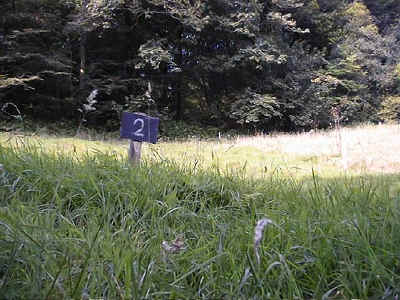 |
Section 2 was dominated by grasses, particularly Yorkshire Fog and Common
Bent. The grasses tended to have very thick, matted, tussocky bases which limited the growth of other ground cover plants such mosses. The section contained small amounts of Bracken, contrasting markedly with the autumn-cut strips on either side of it (1 and 3) which contained quite large areas of Bracken. |
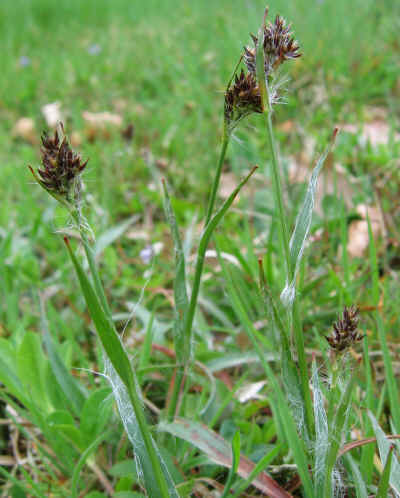 |
Section 2 also contained woodrushes (left) and Yellow Pimpernel, together with some Greater Bird's-foot Trefoil. |
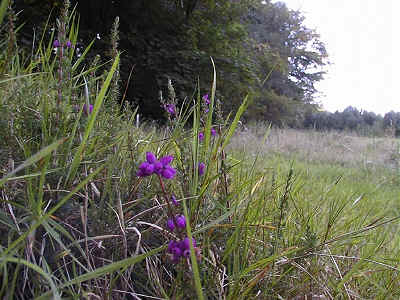 |
Bell Heather was noted growing at the top of Section 2. This was the first time it had been recorded in this section. European, as well as some Western Gorse, a very characteristic plant of heaths in the West of Britain, was also found in this section. Western Gorse was generally rare across the project site and was represented by only a few plants.
|
Section 4
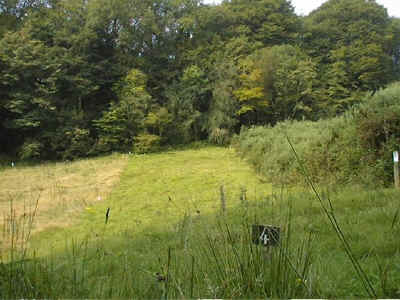 |
Section 4 was similarly dominated by grasses, with Yorkshire Fog and
Common Bent occurring in virtually every single quadrat sampled. The grasses in section 4 also had thick matted bases and hence there was very little in the way of mosses. Sedges and in particular Wood Sedge, were dominant in this strip. Compact Rush was also abundant in the lower half of the section (foreground - left). |
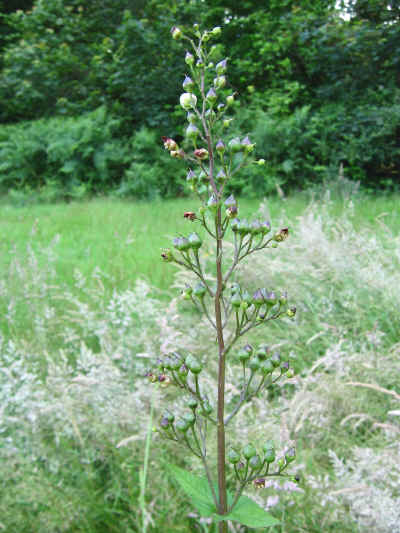 |
Section 4 is a much larger strip than Section 2 and also tends to have a
slightly warmer, less shaded microclimate, because it is less influenced by adjacent
woodland. As a result this section contained a much greater range of species than Section
2. Brambles, Marsh Thistles and some European Gorse were notable on this predominantly grassy area. Foxgloves and Common Figwort (left) were also relatively common in this section. |
 |
Several small isolated patches of Heather (left) and Bell
Heather were also noted in Section 4 for the first time.
|
Section 7
(Spring cut plus initial grass and gorse control)
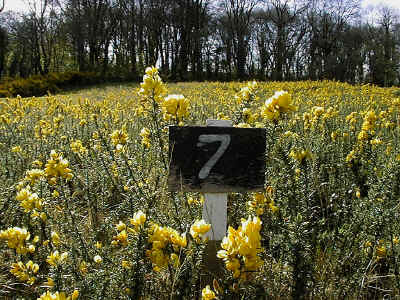 |
Section 7 bore very little resemblance to the other 2 spring cut sections
previously described. This section was dominated by low growing European Gorse and a mixture of sedges, particularly in the lower half of the section.
|
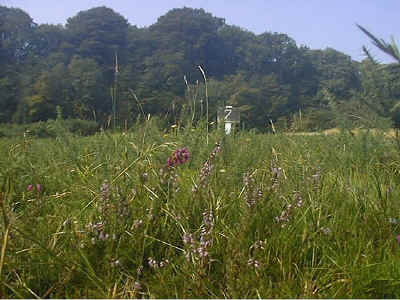 |
This section also contained the greatest concentration of Bell Heather found on the project site, together with substantial amounts of Heather. (Both species are visible in the foreground in the picture on the left.) Tormentil, another heath species was also present.
|
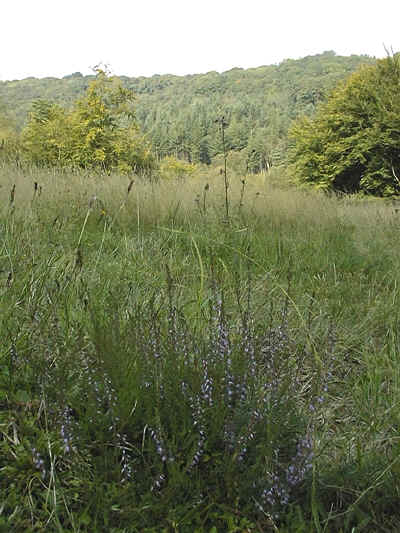 |
The top half of section 7 was more similar to the other spring cut
sections, although still substantially different. This half was dominated by a mixture of grasses (mainly Common Bent) together with Heathers, Marsh Thistle, Wood Sage and large numbers of Silver Birch seedlings. |
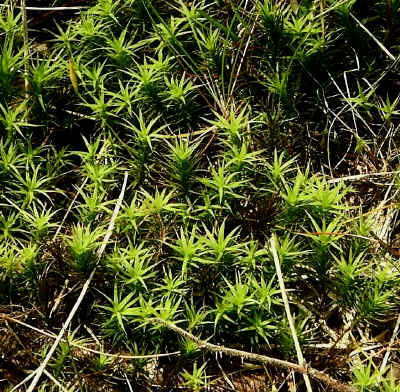 |
This section had considerable moss ground cover, with an abundance of Polytrichum formosum (left) and Eurhynchium praelongum. Hypnum jutlandicum, which is a characteristic heath species, also occurred in over a quarter of the quadrats sampled.
|
Dominant Plants in
Spring Cut Sections in 1999
with figures from 1998 for comparison.
Characteristic heath species
are in bold print
A + sign indicates the species was present, but not recorded in the quadrats.
| Species | Section 2 | Section 4 | Section 7 | |||
| Overall % frequency (mean % cover in brackets) | 1999 | 1998 | 1999 | 1998 | 1999 | 1998 |
| Yorkshire Fog | 95 (46) | 90 (64) | 100 (54) | 100 (46) | 39 (6) | 48 (13) |
| Common Bent | 85 (42) | 95 (34) | 94 (25) | 100 (35) | 74 (15) | 81 (30) |
| Bramble | 50 (6) | 52 (8) | 65 (8) | 50 (5) | 43 (7) | 24 (5) |
| Velvet Bent | 50 (13) | 0 | 12 (3) | 0 | 0 (0) | 24 (2) |
| Eurhynchium praelongum | 50 (15) | 10 (2) | 12 (2) | 6 (0.5) | 74 (33) | 5 (0.5) |
| Polytrichum formosum | 50 (19) | 14 (4) | 24 (3) | 31 (14) | 70 (31) | 43 (24) |
| Thuidium tamarascinum | 40 (15) | 5 (2) | 0 | 6 (1) | 52 (25) | 33 (9) |
| Atrichum undulatum | 15 (2) | 0 | 12 (1) | 0 | 30 (3) | 0 |
| Hypnum jutlandicum | 15 (7) | 5 (1) | 0 | 12 (2) | 26 (2) | 14 (1) |
| Common Dog-violet | 35 (3) | 33 (2) | 76 (21) | 81 (17) | 43 (4) | 57 (5) |
| Pill Sedge | 30 (5) | 24 (2) | 12 (1) | 6 (1) | 17 (2) | 33 (6) |
| Wood Sage | 25 (3) | 33 (4) | 12(1) | 19 (3) | + | 0 |
| Wood Sedge | 0 | 0 | 53 (14) | 44 (5) | 0 | 5 (1) |
| Green-ribbed Sedge | 0 | 24 (4) | 0 | 6 (1) | 35 (9) | 33 (5) |
| Smooth-stalked Sedge | 15 (3) | 0 | 12 (2) | 0 | 48 (19) | 43 (11) |
| Heath Woodrush | 15 (2) | 5 (0.5) | 6 (0.5) | 0 | 48 (10) | 29 (1) |
| Yellow Pimpernel | 20 (4) | 14 (2) | 59 (9) | 56 (6) | 9 (1) | 10 (0.5) |
| Compact Rush | 15 (1) | 0 | 41 (4) | 31 (2) | 52 (5) | 38 (5) |
| Greater Bird's-foot Trefoil | + | 5 (0.5) | 29 (2) | 38 (5) | 9 (0.5) | 5 (0.5) |
| Silver Birch | 0 | 5 (0.3) | 18 (2) | 44 (3) | 52 (6) | 38 (5) |
| Cherry | 0 | 0 | 0 | 0 | 26 (5) | 14 (2) |
| European Gorse | 10 (2) | 14 (2) | 6 (3) | 12 (2) | 74 (34) | 57 (14) |
| Bugle | 0 | 5 (0.2) | 59 (11) | 38 (8) | 4 (0.5) | 0 |
| Heather | 0 | 0 | + | 0 | 35 (9) | 14 (4) |
| Bell Heather | 5 (2) | 0 | + | 0 | 39 (11) | 5 (0.5) |
| Heath Speedwell | 0 | 5 (0.2) | 12 (2) | 19 (2) | 30 (3) | 33 (4) |
| Marsh Bedstraw | 5 (0.2) | 0 | 24 (6) | 6 (0.2) | 0 | 0 |
| Marsh Thistle | 0 | 0 | 24 (8) | 6 (1) | + | 5 (1) |
| Percentage frequency = the percentage of the total number of quadrats sampled over the whole site which contain the species. For example, a percentage frequency of 100%, means that the species was found in all quadrats sampled. |
| Summary: Comparison between the sections: A total of 29 plant species were dominant in one or more of the spring cut sections. Sections 2 and 4 were quite similar. They were basically grassland habitats with a variety of small herbs and small amounts of bramble and gorse. Section 7 was very dissimilar to the other two spring cut sections. This section had less than half the grass cover of sections 2 and 4 (with the dominant grass species in all three strips being Yorkshire Fog and Common Bent). Section 7 was instead dominated by heath species such as gorse, heathers and sedges. It was one of the sections most resembling a heathland habitat in 1999 (along with sections 8 and 9). Section 7 is in the northern half of the Heathland Restoration Project area. This half of the site is much more open, less dominated by woodland and has a much warmer microclimate than sections 1- 4 in the southern half of the project site. However, while there are undoubtedly some environmental differences between section 7 and the other two spring cut sections, it is extremely unlikely that the observed major vegetational differences are entirely due to environmental causes.
Section 7 is not only extremely different to the other spring cut sections, but is also visibly entirely different to the differently managed sections on either side of it which share similar environmental conditions. The observed differences also exactly follow the white boundary markers all the way up the section (see picture above). This clearly shows that the marked differences in vegetation in section 7 are a direct result of the management regime applied to this section alone. The management of section 7 has differed from the other two spring cut sections in only two respects: - the initial control of regenerating gorse and grasses. The vegetation regenerating on this section after the second clearance of the entire project site was treated once with Garlon, which acts against gorse and once with Kerb granules which specifically control grasses. Clearly, the Garlon application had no lasting controlling effect on the gorse. Indeed, gorse was dominant in this section within the first year (table). The Garlon would presumably need to be applied more often than once, possibly at regular intervals, in order to have a lasting controlling effect. The greatest effect of the management in this section seems to have been in restricting grass regeneration. Over most of the rest of the project site, grasses were initially very dominant (table), outcompeting other herbaceous species. The restriction of initial grass growth in this section seems to have been vitally important, allowing other species the chance to become established to a point where they were then able to successfully compete with the grasses. The spring cut sections in more detail:
Changes since the previous year:
|
>> Continue to Autumn Cut Section Descriptions
Ecological Survey 1999 |